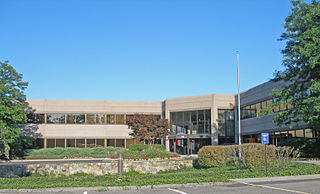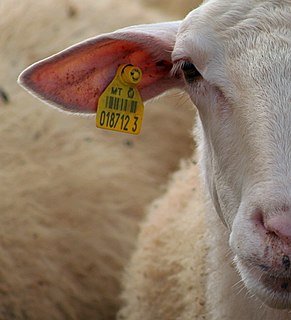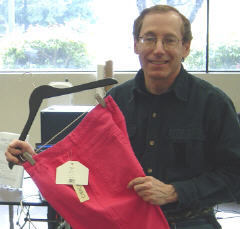Related Research Articles
Radio-frequency identification (RFID) uses electromagnetic fields to automatically identify and track tags attached to objects. An RFID system consists of a tiny radio transponder, a radio receiver and transmitter. When triggered by an electromagnetic interrogation pulse from a nearby RFID reader device, the tag transmits digital data, usually an identifying inventory number, back to the reader. This number can be used to track inventory goods.

Gartner, Inc, officially known as Gartner, is a global research and advisory firm providing information, advice, and tools for leaders in IT, finance, HR, customer service and support, communications, legal and compliance, marketing, sales, and supply chain functions. Its headquarters are in Stamford, Connecticut, United States. The firm changed its name from Gartner Group, Inc to Gartner in 2000. It is a member of the S&P 500.

Near-Field Communication (NFC) is a set of communication protocols for communication between two electronic devices over a distance of 4 cm or less. NFC offers a low-speed connection with simple setup that can be used to bootstrap more-capable wireless connections.
Smartdust is a system of many tiny microelectromechanical systems (MEMS) such as sensors, robots, or other devices, that can detect, for example, light, temperature, vibration, magnetism, or chemicals. They are usually operated on a computer network wirelessly and are distributed over some area to perform tasks, usually sensing through radio-frequency identification. Without an antenna of much greater size the range of tiny smart dust communication devices is measured in a few millimeters and they may be vulnerable to electromagnetic disablement and destruction by microwave exposure.

The Auto-ID Labs network is a research group in the field of networked radio-frequency identification (RFID) and emerging sensing technologies. The labs consist of seven research universities located on four different continents. These institutions were chosen by the former Auto-ID Center to design the architecture for the Internet of Things together with EPCglobal. The federation was established in 1999; the network they have developed is at the heart of a proposal sponsored by EPCglobal and supported by GS1, GS1 US, Wal-Mart, Hewlett-Packard, and others to use RFID and the Electronic Product Code (EPC) in the identification of items in the supply chain for companies. The areas of expertise range from hardware to software to business research related to RFID.
Automatic identification and data capture (AIDC) refers to the methods of automatically identifying objects, collecting data about them, and entering them directly into computer systems, without human involvement. Technologies typically considered as part of AIDC include QR codes, bar codes, radio frequency identification (RFID), biometrics, magnetic stripes, optical character recognition (OCR), smart cards, and voice recognition. AIDC is also commonly referred to as "Automatic Identification", "Auto-ID" and "Automatic Data Capture".

An ear tag is a plastic or metal object used for identification of domestic livestock and other animals. If the ear tag uses Radio Frequency Identification Device (RFID) technology it is referred to as an electronic ear tag. Electronic ear tags conform to international standards ISO 11784 and ISO 11785 working at 134.2 kHz, as well as ISO/IEC 18000-6C operating in the UHF spectrum. There are other non-standard systems such as Destron working at 125 kHz. Although there are many shapes of ear tags, the main types in current use are as follows:

Paul A. Moskowitz works at the IBM Thomas J. Watson Research Center in New York. Moskowitz is a graduate of Stuyvesant High School in New York City, received a Ph.D. in physics at New York University, and has held research and teaching positions at the Université Grenoble, Johannes Gutenberg-Universität Mainz, and at the University of Colorado Boulder. His early work in the area of nuclear physics resulted in the publication of the Moskowitz-Lombardi rule.

A contactless smart card is a contactless credential whose dimensions are credit-card size. Its embedded integrated circuits can store data and communicate with a terminal via NFC. Commonplace uses include transit tickets, bank cards and passports.
Intermec is a manufacturer and supplier of automated identification and data capture equipment, including barcode scanners, barcode printers, mobile computers, RFID systems, voice recognition systems, and life cycle services.
Gideon I. Gartner was the founder of Gartner, Inc. a Stamford, Connecticut information technology (IT) research and advisory company.
Information and communication technology in agriculture, also known as e-agriculture, focuses on the enhancement of agricultural and rural development through improved information and communication processes. More specifically, e-agriculture involves the conceptualization, design, development, evaluation and application of innovative ways to use information and communication technologies (ICTs) in the rural domain, with a primary focus on agriculture. ICT includes devices, networks, mobiles, services and applications; these range from innovative Internet-era technologies and sensors to other pre-existing aids such as fixed telephones, televisions, radios and satellites. Provisions of standards, norms, methodologies, and tools as well as development of individual and institutional capacities, and policy support are all key components of e-agriculture.
Supranet is a term coined at the turn of the 21st century by information technology analysis firm Gartner to describe the fusion of the physical and the digital (virtual) worlds, a concept that embeds the "Internet of things" as one of its elements.
The Internet of things (IoT) describes the network of physical objects—“things”—that are embedded with sensors, software, and other technologies for the purpose of connecting and exchanging data with other devices and systems over the Internet.
AlphaIC is a method for assessing the value of information technology (IT) investments that surpasses banal ROI analyses and looks at how IT affects an organization's intellectual capital.
A smart object is an object that enhances the interaction with not only people but also with other smart objects. Also known as smart connected products or smart connected things (SCoT), they are products, assets and other things embedded with processors, sensors, software and connectivity that allow data to be exchanged between the product and its environment, manufacturer, operator/user, and other products and systems. Connectivity also enables some capabilities of the product to exist outside the physical device, in what is known as the product cloud. The data collected from these products can be then analyzed to inform decision-making, enable operational efficiencies and continuously improve the performance of the product.
Deister Electronic is the name generally used to refer to Deister Electronic GmbH Barsinghausen, Germany, and its subsidiaries in North America. Deister Electronic is an industrial enterprise specialised on electronic non-contact identification and security systems founded in 1977. In North America, the companies are Deister Electronics USA, Inc. of Manassas, VA, and Deister Electronics, Inc. of Ontario, Canada.
Real-time locating systems (RTLS), also known as real-time tracking systems, are used to automatically identify and track the location of objects or people in real time, usually within a building or other contained area. Wireless RTLS tags are attached to objects or worn by people, and in most RTLS, fixed reference points receive wireless signals from tags to determine their location. Examples of real-time locating systems include tracking automobiles through an assembly line, locating pallets of merchandise in a warehouse, or finding medical equipment in a hospital.
The ucode system is an identification number system that can be used to identify things in the real world uniquely. Digital information can be associated with objects and places, and the associated information can be retrieved by using ucode.
The Industrial Internet of Things (IIoT) refers to interconnected sensors, instruments, and other devices networked together with computers' industrial applications, including manufacturing and energy management. This connectivity allows for data collection, exchange, and analysis, potentially facilitating improvements in productivity and efficiency as well as other economic benefits. The IIoT is an evolution of a distributed control system (DCS) that allows for a higher degree of automation by using cloud computing to refine and optimize the process controls.
References
- ↑ Who's Who in the World 1998, 15th Edition, Marquis, New Providence, NJ
- ↑ Australian National Training Authority, "Radio Frequency Identity Tags", in Shared Technology: A Road Map for Traditional and Emerging Industries to 2008, Chapter 17, Anta Publishers, Brisbane, Australia, September 2003
- ↑ F.Frey, S.Williams-Allen, H.Vogl, L.Chandra, "Digital Asset Management: A Closer Look At The Literature", A Research Monograph at the Print Industry Center at the Rochester Institute of Technology, Rochester, NY, March 2005
- ↑ P.Griffiths, D.Remenyi, "Information Technology in Financial Services: A Model for Value Creation", Electronic Journal of Information Systems Evaluations, 2003 / Issue 2 / paper 12, ACI, Reading, UK
- ↑ European Commission, Directorate-General XIII – Information Technology, ESPRIT Project Information Services and Summaries, Brussels, 1992
- ↑ US Patent 7118034: "Systems and methods for package sortation and delivery using radio frequency identification technology", A.Baldassari, D.Anderson, R.Peters (United Parcel Service of America), October 10, 2006
- ↑ Scientific service of the French Embassy in Norway, Science and Technology In France, N.13, J.B. Gouyon ed., May 2002
- ↑ P.Magrassi, "E-Tagging: From Niches to the Supranet", Research Note, Gartner, Stamford (CT), USA, 2001.
- ↑ P.Magrassi, "A World Of Smart Objects: The Role Of Auto Identification Technologies", Strategic Analysis Report, Gartner, Stamford (CT), USA, 2001.